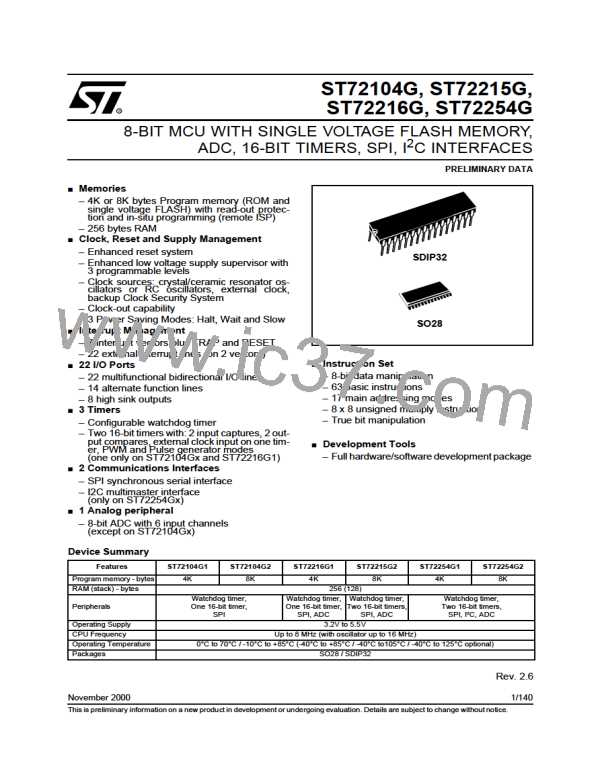ST72104G, ST72215G, ST72216G, ST72254G
ST7 ADDRESSING MODES (Cont’d)
13.1.6 Indirect Indexed (Short, Long)
SWAP
Swap Nibbles
This is a combination of indirect and short indexed
addressing modes. The operand is referenced by
its memory address, which is defined by the un-
signed addition of an index register value (X or Y)
with a pointer value located in memory. The point-
er address follows the opcode.
CALL, JP
Call or Jump subroutine
13.1.7 Relative Mode (Direct, Indirect)
This addressing mode is used to modify the PC
register value by adding an 8-bit signed offset to it.
Available Relative Direct/
Function
The indirect indexed addressing mode consists of
two sub-modes:
Indirect Instructions
JRxx
Conditional Jump
Call Relative
Indirect Indexed (Short)
CALLR
The pointer address is a byte, the pointer size is a
byte, thus allowing 00 - 1FE addressing space,
and requires 1 byte after the opcode.
The relative addressing mode consists of two sub-
modes:
Indirect Indexed (Long)
Relative (Direct)
The pointer address is a byte, the pointer size is a
word, thus allowing 64 Kbyte addressing space,
and requires 1 byte after the opcode.
The offset follows the opcode.
Relative (Indirect)
The offset is defined in memory, of which the ad-
dress follows the opcode.
Table 20. Instructions Supporting Direct,
Indexed, Indirect and Indirect Indexed
Addressing Modes
Long and Short
Function
Instructions
LD
Load
CP
Compare
AND, OR, XOR
Logical Operations
Arithmetic Addition/subtrac-
tion operations
ADC, ADD, SUB, SBC
BCP
Bit Compare
Short Instructions Only
CLR
Function
Clear
INC, DEC
Increment/Decrement
Test Negative or Zero
1 or 2 Complement
Bit Operations
TNZ
CPL, NEG
BSET, BRES
Bit Test and Jump Opera-
tions
BTJT, BTJF
SLL, SRL, SRA, RLC,
RRC
Shift and Rotate Operations
92/140

 ETC [ ETC ]
ETC [ ETC ]